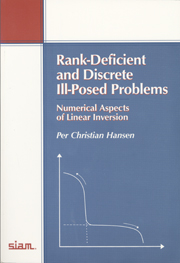Rank-Deficient and Discrete Ill-Posed Problems
Here is an overview of modern computational stabilization methods for linear inversion, with applications to a variety of problems in audio processing, medical imaging, seismology, astronomy, and other areas. Rank-deficient problems involve matrices that are exactly or nearly rank deficient. Such problems often arise in connection with noise suppression and other problems where the goal is to suppress unwanted disturbances of given measurements.
Discrete ill-posed problems arise in connection with the numerical treatment of inverse problems, where one typically wants to compute information about interior properties using exterior measurements. Examples of inverse problems are image restoration and tomography, where one needs to improve blurred images or reconstruct pictures from raw data. This book describes new and existing numerical methods for the analysis and solution of rank-deficient and discrete ill-posed problems. The emphasis is on insight into the stabilizing properties of the algorithms and the efficiency and reliability of the computations.
Product details
No date availablePaperback
9780898714036
263 pages
255 × 175 × 15 mm
0.46kg
Table of Contents
- Preface
- Symbols and Acronyms
- 1. Setting the Stage. Problems With Ill-Conditioned Matrices
- Ill-Posed and Inverse Problems
- Prelude to Regularization
- Four Test Problems
- 2. Decompositions and Other Tools. The SVD and its Generalizations
- Rank-Revealing Decompositions
- Transformation to Standard Form
- Computation of the SVE
- 3. Methods for Rank-Deficient Problems. Numerical Rank
- Truncated SVD and GSVD
- Truncated Rank-Revealing Decompositions
- Truncated Decompositions in Action
- 4. Problems with Ill-Determined Rank. Characteristics of Discrete Ill-Posed Problems
- Filter Factors
- Working with Seminorms
- The Resolution Matrix, Bias, and Variance
- The Discrete Picard Condition
- L-Curve Analysis
- Random Test Matrices for Regularization Methods
- The Analysis Tools in Action
- 5. Direct Regularization Methods. Tikhonov Regularization
- The Regularized General Gauss–Markov Linear Model
- Truncated SVD and GSVD Again
- Algorithms Based on Total Least Squares
- Mollifier Methods
- Other Direct Methods
- Characterization of Regularization Methods
- Direct Regularization Methods in Action
- 6. Iterative Regularization Methods. Some Practicalities
- Classical Stationary Iterative Methods
- Regularizing CG Iterations
- Convergence Properties of Regularizing CG Iterations
- The LSQR Algorithm in Finite Precision
- Hybrid Methods
- Iterative Regularization Methods in Action
- 7. Parameter-Choice Methods. Pragmatic Parameter Choice
- The Discrepancy Principle
- Methods Based on Error Estimation
- Generalized Cross-Validation
- The L-Curve Criterion
- Parameter-Choice Methods in Action
- Experimental Comparisons of the Methods
- 8. Regularization Tools
- Bibliography
- Index.





